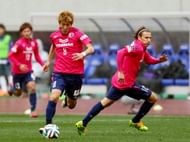The Japanese Football League 2014 started last weekend. The J-League is the most organized Football League in Asia and one of the registered trademarks of the competition is to always have a lot of Brazilian players. For this current season, there are 29 players from Brazil who will be turning out for 14 of the 18 teams that are part of the premier division, which means 62% of the foreign players involved in the championship are Brazilian.
The explanation for this phenomenon is simple. Since Japanese football went professional in the early 1990s, Japanese leaders chose Brazilian football as a mirror and reference. Scientific and methodical to the core, they created a strategic plan with the title “J-League: a project for 100 years”.
The alignment to the Brazilian school of thought is part of the long term plan. For this reason, the vast majority of foreign football athletes who play in the country have been Brazilian, in every season since 1992.
The Brazilian football model is a blend of technique, skill and excellence of play which has won them five World Cups. This in association with the natural Nipponese style, which is vertical and speedy, helped create the current brand of Japanese football. It all began in the first edition of the J-League in 1992 – which had the charismatic Brazilian playmaker Zico as the biggest attraction
Currently, the Japanese national team is the most successful team in the continental tournaments in the past two decades. They play the best football in the region, and are also the most competitive national team of Asia. They will play this year in their fifth consecutive World Cup since they made their debut at France in 1998.
This year’s attractions are all veterans – Diego Forlán now part of the J-League!The current J-League edition has an interesting fact; the biggest stars are experienced players. The former Celtic playmaker Shunsuke Nakamura, 35 years old, is a key-element of the Yokohama Marinos. Graceful, technically solid and exceptional with set pieces, he was a hero at Celtic and left a great impression in Italy based on his time spent at Reggina.
Along with the midfielder Hidetoshi Nakata, he was probably the best Japanese to have played in Europe in the past decade.
Almost with the same profile, the midfielder Yasuhito Endo is another star of the tournament. He plays for Gamba Osaka, is 35 years old and has played more than 140 games for the Japanese national team (a record!). He is called the “Japanese Pirlo” by the local press.
The major star of the current edition is certainly the Uruguayan striker Diego Forlán, aged 34. Voted the best player at the World Cup 2010 and awarded the Pichichi trophy twice (2004/05 and 2008/09), he is by far the biggest star to have played in the J-League since Zico.
What invites them to come to the J-League is the fact that it is an organized league that has never faced any corruption scandal, the stadiums have great public attendances, and is impeccably organized, all which point to the extent to which the J-League has progressed.
STAT
The oldest player in the league is the Brazilian left-back Dutra, who plays for Yokohama Marinos. He will turn 41 in August and is hugely popular.
J-League 2014 – First round/ RESULTS
Vegalta Sendai 1 – 2 Albirex Niigata
Ventforet Kofu 0 – 4 Kashima Antlers
Nagoya Grampus 2 – 3 Shimizu S-Pulse
Cerezo Osaka 0 – 1 Sanfrecce Hiroshima
Sagan Tosu 5 – 0 Tokushima
Kashiwa Reysol 1 – 1 Tokyo FC
Gamba Osaka 0 – 1 Urawa Red Diamonds
Yokohama Marinos 2 – 0 OmyiaArdija
Kawasaki Frontale 2 – 2 Vissel Kobe

